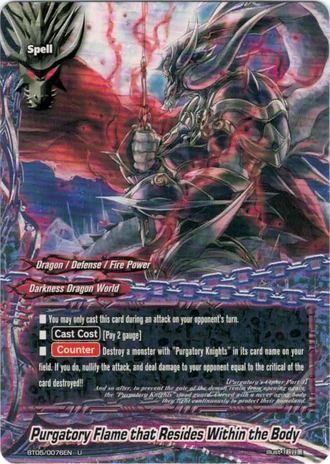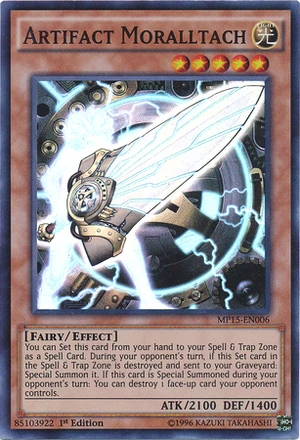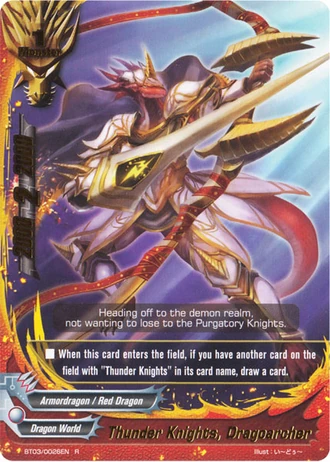Unfortunatly, it also causes a lot of chaos because this is something that too much players ignore. A lot of those players use the assumption that Buddyfight works the same way that X other card game work.
This is why I want to explain how the most important rule in buddyfight works : Skill activations.

 First of, I want to talk about targeting. There is no Artifact Moraltach who doesn't target the opponent monster because it is written differently. Star Guardian, Jackknife targets, Purgatory flames that reside with the body targets the card you have to tribute, Beast Deity, Tigerthrust 's act targets the item it will go to the soul.
First of, I want to talk about targeting. There is no Artifact Moraltach who doesn't target the opponent monster because it is written differently. Star Guardian, Jackknife targets, Purgatory flames that reside with the body targets the card you have to tribute, Beast Deity, Tigerthrust 's act targets the item it will go to the soul.As long as it is not an Area Of Effect skill and designs a precise card outside of the deck, IT TARGETS.
Let's get into the fun part : In Buddyfight, spell activation and
monster effect don't work the same way.
Spells work like in any other card games : You cast it then pay the price then you target the monsters. Your opponent then has a play timing. And after the opponent's chain card resolve (if any), you resolve your spell.
Spells work like in any other card games : You cast it then pay the price then you target the monsters. Your opponent then has a play timing. And after the opponent's chain card resolve (if any), you resolve your spell.
When the condition is met, you can pay the cost to activate the skill, you then choose the targets of the skill.
Your opponent has a counter timing, then resolves it.
You resolve your skill.
Here is how it works in Buddyfight :
When the 'condition' is met, you can choose the ressources for the 'cost' and choose the targets of the skill.
Your opponent has a counter timing, then resolves it.
You resolves your skill.
See the difference ? Yep, you actually
pay the 'cost' AT the resolution of the skill. This means two things :
- The 'cost' of the skill is still
not payed when your opponent gets the time to play his counter- The 'cost' of the skill is still not payed when you target.
.png/revision/latest/scale-to-width-down/330?cb=20151001020343) You probably noticed the word cost was inside quotes. This is because I used a commonly (and mistakely) used word. But the correct word would be 'condition'. The discard one card of Demon lord Asmodai may feel like a cost, but it is part of the condition. Just like the 'If you control one weapon' condition of Kamil.
You probably noticed the word cost was inside quotes. This is because I used a commonly (and mistakely) used word. But the correct word would be 'condition'. The discard one card of Demon lord Asmodai may feel like a cost, but it is part of the condition. Just like the 'If you control one weapon' condition of Kamil. Hopefully now it becomes more clear. The cost (Call cost, Cast cost, Equip cost) is payed immediatly. The condition is checked/fufilled at the resolution.
Here is how a skill is written : Trigger (when Asmodai/Kamil is called), Condition (Asmodai : pay one gauge/Kamil : you have an item equiped), Skill (Destroy a monster or Search an item).
Let's use precise example to put it into application
Can I use Trio! and grab a monster the monster I want to pay the gauge cost with ?
Yes. You pay the cast cost, then you target.
.png/revision/latest?cb=20160113004628) Can I activate Infinite Armament, Dangerous Cradle's effect, pay with an item that is in the gauge and take this item that was paied in the soul ?
Can I activate Infinite Armament, Dangerous Cradle's effect, pay with an item that is in the gauge and take this item that was paied in the soul ? No. As an act ability, you need to declare what gauge you pay, then target the item. At the declaration of the target, you still don't have payed the gauge of the condition and the item you wanted to absorb is still in the gauge.
No. As an act ability, you need to declare what gauge you pay, then target the item. At the declaration of the target, you still don't have payed the gauge of the condition and the item you wanted to absorb is still in the gauge.I only have Thunder Knights, Halberd Dragon on the field, I call Thunder Knights, Dragoarcher's and activate his effect. My opponent answers with Death grop on Halbert. Do I draw a card ?
No. When Dragoarcher resolves, the condition cannot be fufilled because there is no other Thunder Knights anymore, the condition cannot be fufilled.
I hope you learned something, in my next article, I will cover the difference between optional and madatory.
In the meantime, you can read the precise rulebook here.
Until next time,
raise your flag...
please.
Thank you Nico and Tim for your help.


.png/revision/latest/scale-to-width-down/330?cb=20150909182219)

Aucun commentaire:
Enregistrer un commentaire